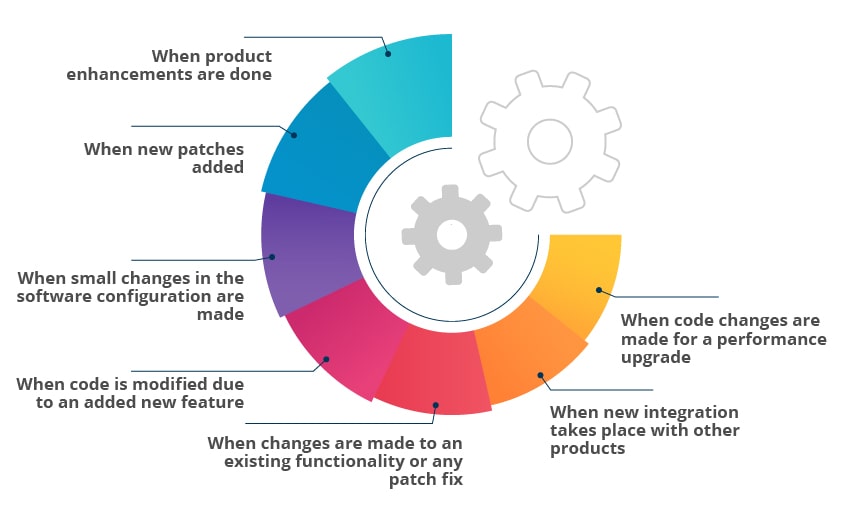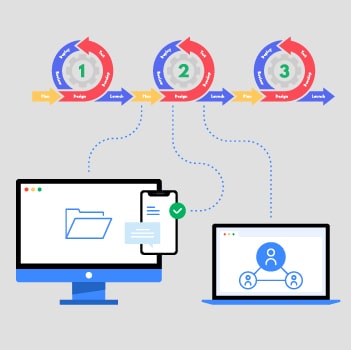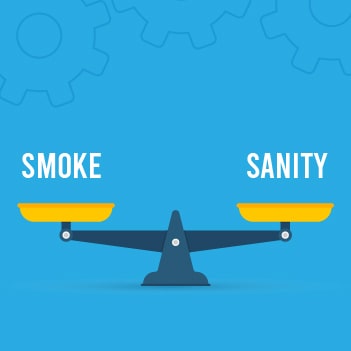Published: 21 Jul 2020
What is the Significance of Regression Testing in the Agile?
Last Updated: 28 Mar 2024
Content
1. When should Regression Testing be taken up?
2. What are the Various Types of Regression Testing?
3. Significance of Regression Testing in Agile
4. Benefits with Regression Testing taken up in Agile Environments
5. Regression Testing challenges faced by agile team
6. Best Practices to follow for Regression Testing in Agile
7. Conclusion
When should Regression Testing be taken up?

Regression testing should be taken up on a new build when there has been a significant change in the original functionality even with a single bug fix. It is usually performed after verification of changes or when new functionality is added and should be repeatedly tested with every new function. In most conditions, it can be considered as a retest of tests and this testing method should be taken up in various situations such as
– When product enhancements are done
– When new patches added
– When small changes in the software configuration are made
– When code is modified due to an added new feature
– When changes are made to existing functionality or any patch fix
– When new integration takes place with other products
– When code changes are made for a performance upgrade
Specifically, all these above instances should be regression tested to ensure all functionalities remain unaffected even with new changes.
Under agile and DevOps practices, regression testing plays a critical role as continuous testing is the key to these methodology’s success to maintain product stability. Testers continue to follow shift-left testing to ensure effective testing to be done along with development.
Moreover, teams use regression testing to ensure the tested functionality continues to remain the same even when new functionality features are all developed within sprints.
Now, let us now try to know about various types of regression testing such as unit, partial, complete, and build-level regression testing types which have been detailed below.
What are the Various Types of Regression Testing?

Unit regression testing:

This is an important type of regression testing that should be taken up during the initial unit testing phase which tests the code as a single unit. This form of regression testing has a narrow approach and is focused on individual units of code.
Partial regression testing:

This form of regression testing is performed to check problems when making slight changes to the code. This testing process ensures to make the system work properly even after adding new code or when even slight code changes are made.
Complete regression testing:

It is a comprehensive regression testing method that involves testing the changed units as well as any old features of the application. It is commonly taken up to test when more than one code change has been done. This testing has to be performed before any major release or product delivery to ensure all functionalities continue to work seamlessly.
Build-level regression testing:

This method of regression testing at build-level corresponds to testing during the second build of upcoming release and is usually taken up when some code changes are done across the builds.
Significance of Regression Testing in Agile

Agile methodology revolves around fast and iterative processes with sprint cycles which are short and churn out features for each cycle. Specifically, the testing cycles should also be short to keep up proper balance between the sprint development and the iterative testing cycles that follow them.
Basically, the agile development is fast and dynamic and developers churn features in quick times. It is necessary that the testing cycles should also go hand-in-hand to deploy the new features after testing them.
In a true sense, development is done on one feature and essentially the testing has to be done on all new and old features that were developed earlier. It is a priority and necessity that with every new build, the regression testing has to be taken up to make sure that the new addition or improvement in the code does not compromise the functionality of existing features.
Thus, the regression testing has its own significance and this testing process ensures functionalities remain unaffected for every build. This regression testing process is critical for product’s success as it ensures all functionalities work in accordance with the given requirements in an agile environment.
Benefits with Regression Testing taken up in Agile Environments

– Helps to build a stable product as testing is taken up in sprints in agile environment to check whether the newly developed or existing functionalities are working as per the requirements
– Identifies any functionality issues early in the product development life cycle and ensures quicker resolution of these defects
– Automating regression testing in agile processes helps to reduce re-work and frees up the testers to be used for other important testing activities
– Effective regression testing embedded in agile practice helps to improve the overall quality of the product along with ensuring great user experience
Moreover, in agile scenarios with iterative changes, there are more frequent build cycles and continuous changes are added to the application. Therefore, in order to test these frequent changes, software regression testing should be taken up in agile practices.
Thus, for successful regression testing in agile, the QA teams should follow best regression testing practices and build effective regression testing suite from the onset of software product development to ensure all functionalities work effectively.
Regression Testing challenges faced by agile team
1. Too many changes:
During the software development process, there will be instances where the management and customers will ask for changes in line with requirements. These changes can prove to be unstable, due to which the efficiency of the test automation strategy can be dampened.
2. Time-consuming:
Testing large applications consumes a lot of time. To create and maintain a regression test suite requires a lot of time too.
3. Unable to manage regression tests:
With each sprint, the scale of regression tests increases. In the case of large projects, it is really difficult to manage regression tests. In order to manage regression tests properly, testing teams should automate and review tests on a continual basis. Ineffective tests must also be removed in the process.
4. Poor communication:
There should be an effective communication channel and proper strategic communication taking place between the testing team, developers, business analysts and business stakeholders. This will ensure that the regression testing process is streamlined. Through effective communication, specific features that have to undergo regression testing can be correctly ascertained.
5. Maintenance is a time-consuming process:
It takes quite a bit of time to maintain and update the regression testing suite. Time is consumed when new test cases are included or the existing ones are updated.
Best Practices to follow for Regression Testing in Agile

1. Define effective regression test strategy:

It is of utmost importance in an agile process to define an efficient test strategy for regression testing<.
In order to get effective regression test strategy, it should include
– Gathering all test cases
– Identifying the improvements that can be made for the test cases
– Estimating the time required for execution of these test cases
– Outlining of which of them can be automated and which ones to be manually tested
This sort of elaborate development of regression test strategy ensures effective testing results.
2. Conduct smoke and sanity tests:

It is necessary to conduct smoke and sanity tests before regression testing is actually conducted, as it saves time for testing teams. Sanity tests ensures a run-through of the basic functionality of an application and smoke tests are used to test the start or initial workflows such as login and startup pages. These two initial tests can be used to primarily categorize if the application is too flawed or working fine, and then the actual process of regression testing can be taken up.
3. Leverage test automation:

As every release cycle needs to include regression testing to ensure new developments do not break any other existing functions, it is ideal to adopt test automation to save time and efforts of testers. Effectively, if a parallel run of automated regression testing is performed, then the process can enormously save time and improve the software quality.
Automated regression testing makes the testing process much more efficient as running the same tests over an over again by manual testers is tedious. Automation can free up resources and this automation process can be used to reduce tedious and repetitive tasks.
4. Maintain and update regression packs regularly:

Essentially, a regression pack is a collection of test cases that are executed with new software update for every feature. This regression pack consists of test cases that have been written and drafted using the requirement specifications document. It is necessary to update these test cases with changes in features or with inclusion of new changes and it is also essential to maintain these test cases to ensure effective test results.
5. Adopt complete regression testing:

A comprehensive regression testing is essential and should be carried out and it should cover all the critical conditions. This sort of final regression testing should be taken up to certify that the functionality has not been altered and affected due to new code changes. This testing proves gives a green signal by the testers to move the code to production.
6. Perform continuous testing:

In Agile methodology, continuous testing is the backbone to ensure quality software. The process states to ‘Fail fast’ and ‘fail often’ through continuous testing, such that defects are fixed fast by the developers. These defects are fixed before delivery with minimum impact on software. Moreover, continuous integration and continuous delivery in agile & DevOps practices requires continuous testing with automated regression testing.
Hence, even for any developed software that requires some changes or modifications with passage of time and need, the updates are rolled out in a way that it is essential for the QA team to make sure that all the features are working flawlessly. In order to achieve this functionality stability for every feature, regression testing needs to be adopted.
Conclusion
Today’s businesses need quality software that is bound to deliver great customer experience and at the same time they need shorter release cycles. Therefore, it is necessary to ensure high-quality products that effectively meet the customer expectations which is achieved by leveraging software testing right from the stage of product development. Adopting effective regression testing in agile and DevOps practices ensures to deliver quality products to the market on time as all features are tested end-to-end to ensure quality product.
TestingXperts expertise with respect to Regression testing revolves around a spectrum of regression testing services that includes:
– Software Regression Testing
– System Integration Regression Testing
– Functional Regression Testing
– Automated Regression Testing
– End-to-End Regression Testing
Our cost-effective regression testing model helps QA teams to deliver a reasonable balance between test selection and fault detection. Leverage our next-gen regression testing services to ensure quality products as regression test automation by our test automation experts ensures to save time, effort and also ensures significant cost reduction. Talk to our experts today